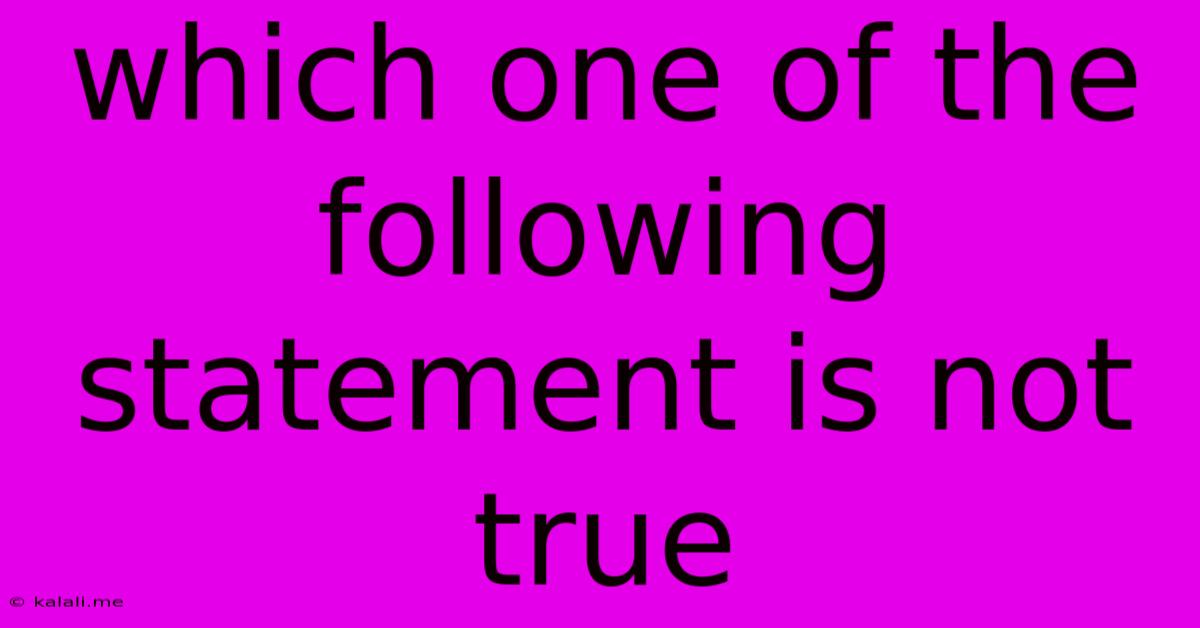Which One Of The Following Statement Is Not True
Kalali
Jun 12, 2025 · 3 min read

Table of Contents
Which One of the Following Statements is Not True? A Guide to Identifying Falsehoods
Determining which statement is false amongst a group requires careful analysis and critical thinking. This skill is vital in various aspects of life, from academic assessments to everyday decision-making. This article will equip you with strategies and techniques to effectively identify false statements, improving your critical thinking skills and accuracy in evaluating information.
Understanding the Challenge: Identifying a false statement isn't just about spotting obvious inaccuracies. It often involves understanding nuances, recognizing logical fallacies, and assessing the credibility of the source. The statements presented might be subtly misleading, requiring a deeper understanding of the subject matter.
Strategies for Identifying False Statements:
Here are key steps to help you determine which statement is inaccurate:
-
Identify the Key Concepts: Before analyzing each statement, understand the core concepts or themes involved. This provides context for evaluating the truthfulness of each claim. For example, if the statements revolve around the history of a particular event, ensure you have a basic understanding of that historical period.
-
Analyze Each Statement Individually: Carefully examine each statement, dissecting its components. Look for keywords, qualifiers, and assumptions that might indicate a falsehood. Pay attention to the language used—are there any weasel words or ambiguous terms?
-
Cross-Reference with Reliable Sources: If the statements relate to verifiable facts, consult credible sources like encyclopedias, academic journals, or reputable news organizations. Comparing the statements with reliable information will quickly reveal any inaccuracies.
-
Look for Contradictions and Inconsistencies: Often, a false statement will contradict itself or conflict with other statements within the group. Identifying these inconsistencies is a crucial step in identifying the falsehood.
-
Consider Logical Fallacies: Be aware of common logical fallacies such as:
- Straw Man: Misrepresenting an argument to make it easier to attack.
- Appeal to Authority: Accepting a claim solely because an authority figure said it, without further evidence.
- Hasty Generalization: Drawing a conclusion based on insufficient evidence.
- False Dilemma (Either/Or): Presenting only two options when more exist.
-
Evaluate the Source's Credibility: If the statements come from a particular source, assess its trustworthiness. Consider the source's reputation, potential biases, and track record of accuracy.
-
Use Your Reasoning and Judgement: Ultimately, your critical thinking skills are essential. Consider the implications of each statement, and use your reasoning to determine which is most likely to be false.
Example Scenario:
Let's consider a simple example:
- Statement A: The Earth is flat.
- Statement B: The Earth is round (spheroid).
- Statement C: The sun revolves around the Earth.
Using our strategies: we know through overwhelming scientific evidence that Statement A and C are false. Statement B is supported by centuries of scientific observation and evidence.
Conclusion:
Identifying false statements is a skill that improves with practice. By employing these strategies and developing your critical thinking abilities, you can confidently navigate information, identify inaccuracies, and make informed decisions based on reliable information. Remember to always approach information critically and verify claims using credible sources. The ability to discern truth from falsehood is essential in today's world of rapidly proliferating information.
Latest Posts
Latest Posts
-
What Is The Value Of X 3 5 7 9
Jun 13, 2025
-
Which Of The Following Is True Of Alternating Current
Jun 13, 2025
-
Wheat Is A Monocot Or Dicot
Jun 13, 2025
-
What Are The Factors Of 360
Jun 13, 2025
-
Find The Lcm Of 15 And 18
Jun 13, 2025
Related Post
Thank you for visiting our website which covers about Which One Of The Following Statement Is Not True . We hope the information provided has been useful to you. Feel free to contact us if you have any questions or need further assistance. See you next time and don't miss to bookmark.